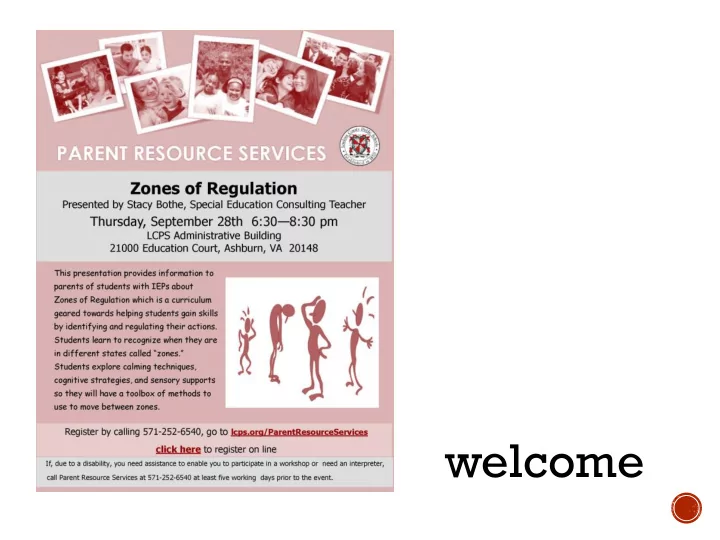

welcome
“I created The Zones of Regulation (The Zones) to help us do just that: support people in managing all the feelings they experience, without passing judgment on what people are feeling or how they are behaving.” Leah Kuypers
HTTP://WWW.ZONESOFREGULATI ON.COM/INDEX.HTML
The ability to manage and direct one’s own physical states, feelings, thoughts, and actions in healthy, pro-active ways to be successful across several domains of life. It is universal…a set of skills everyone needs for success. Also called self-control, emotion regulation, coping, impulse control, executive function, etc.
Directly related to success in learning, Is critical for success in academic performance, school, work, and life social interaction, overall health, safety and more. A better predictor of Correlates highly with academic success than longevity and happiness IQ.
Self-regulation abilities Research shows that Higher academic have a stronger correlation teachers can have a achievement is more likely with school readiness than positive effect on students’ when interventions include IQ or entry-level reading or self-regulation skills. – self-regulation components. math skills. – Blair, 2002- Burchinal, Peisner- - Blair & Raza, 2007 2003; Normandeau & Guay, Feinberg, Bryant & Clifford, 1998 2000.
Identify one’s physical Identify, express and Manage one’s thoughts state to be able to then manage one’s feelings and engage in calm or arouse one’s in an age appropriate cognitive processes body and physical state and healthy ways such as problem solving and academic learning
Self-regulation skills can be taught. Overall, children learn self-regulation by observing how others, especially significant adults regulated themselves. Self-regulation skills develop gradually, so it is important that adults hold developmentally appropriate expectations for children’s behavior. Some children need direct instruction and practice to learn these skills.
SENSORY MOTOR As adults, we employ techniques PREFERENCES throughout our day to help us navigate our daily challenges. These strategies are used without our “thinking” about their need. They help us either to increase or decrease our state of alertness. What may be alerting for one FOR person may not have the same effect on another person. We are all individuals and our nervous systems react uniquely ADULTS to environment.
• Learning the physical states (Zones), related feelings (for each Zone) and management strategies (for each Zone) • Identifying triggers • Identifying and practicing 2-3 strategies to help us return to the green zone from the blue, yellow and red zones • Making use of a strategy in the moment
It is natural to experience all of the Zones; there is no bad zone. Our Zone is defined by the feelings and internal states we experience on the inside. Our behavior is a byproduct of how we All manage our Zone; therefore, consequences should not be tied to a Zone. Zones The context we are in helps us figure out how to manage our Zone so our behavior meets the demands of the are social environment, and in doing so we are able to achieve the tasks we are trying to accomplish and/or the social goals we’ve set for ourselves in that OK! situation.
The Blue Zone is used to describe low states of alertness and down feelings such as when one feels sad, tired, sick, or bored.
The Green Zone is used to describe a calm state of alertness. A person may be described as happy, focused, content, or ready to learn when in the Green Zone. This is the zone where optimal learning occurs.
The Yellow Zone is also used to describe a heightened state of alertness and elevated emotions, however one has more control when they are in the Yellow Zone. A person may be experiencing stress, frustration, anxiety, excitement, silliness, the wiggles, or nervousness when in the Yellow Zone.
The Red Zone is used to describe extremely heightened states of alertness and intense emotions. A person may be elated or experiencing anger, rage, explosive behavior, devastation, or terror when in the Red Zone.
Drink Bathroom Wall push-up Palm press or tickles Wiggle cushion Lap pad Worry stone Clay Ball chair Chair push-ups Movement break Arm squeezes
Deep breathing Worry dolls Tense and relaxing muscles Worry stones Worry/feeling book Counting to 10 Asking for help
Self-talk Thinking good thoughts Use your imagination Big problem vs. little problem Brain break (Go Noodle) I-messages Talk about it 5 Pt. Scale
Modeling - Parents are the most powerful Talk about what model for Use the Language zone or physical children. Promote of the Zones state is expected healthy self- Program. for a situation or regulation and unexpected. self-care. You can Think Outloud and model using strategies.
Share your physical and Help your child to observations of your emotional states. identify triggers. child’s Assist your child Remember learning with identifying the these skills is a Praise your child’s strategies that work process. It takes effort. for him or her and time and encourage their use. encouragement.
TIPS FOR HANDLING AN UNEXPECTED RED ZONE
http://www.zonesofregulation.com/the-zones-of-regulation-apps.html
Contact Stacey.Bothe@lcps.org QUESTIONS 571-252-1011
Recommend
More recommend